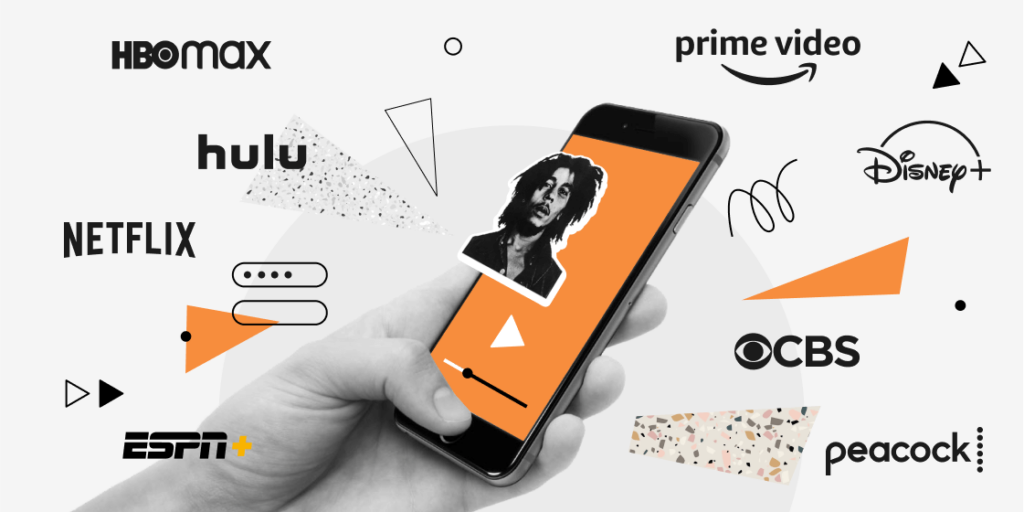OTT, or Over-the-Top, technology is a technology that allows to transfer and display media files via the internet, without the use of cable, satellite, or other traditional technologies. The OTT market has been steadily growing for years, but in the past two years, it has experienced a meteoric rise.
By the end of 2022, the OTT industry is expected to reach $275.3 billion in revenue. In this article, we are going to look at the most notable trends of the OTT technology and what the competition looks like today.
Focus on user experience
With dozens of OTT services currently available on the market, companies are looking for any competitive advantage they can find. And with so many services offering great content, user experience often becomes the one feature that can propel a streaming service to success.
A user won’t tolerate a service that is lacking positive user experience — that is a simple truth of all software solutions created for a wide user audience. And the term “user experience” includes a variety of parameters, some of which may not be that obvious. For example, convenient navigation seems like a no-brainer, but it’s also important to make sure the product is working across all platforms with compatibility testing and verify the stability of the stream under any circumstances with performance testing.
Personalization is essential
A very common reason for a user to join a new streaming service is when that service releases an exclusive piece of content that is not available elsewhere and the user is interested in. But what happens after the user is done with that specific piece of content depends on whether the personalization feature is available at all and how well it works.
When joining a new OTT service or considering sticking with the current one, users will always pay attention to content discovery — in other words, how well the system knows their preferences and how fast it can learn. Users also enjoy being surprised by an OTT service suggesting content that is outside of their typical preferences but is enjoyable nonetheless. This is why smart personalization is key to the product’s success.
Get to know our OTT testing expertise and approach

Localization matters more than ever
OTT services that focus on just one locality throughout their run will hardly ever reach the heights set by services like Netflix, which is available in over 190 countries and is expertly localized in each one. All-encompassing localization helps you reach out to more customers, foster the loyalty of the audience, and ensure steady growth.
Proper localization is not just about making your product available in a foreign language. It’s also about providing location-specific payment options and currencies, offering content that the local audience is more likely to engage with, and making sure your services comply with the country’s laws and regulations. Localization testing helps you make sure you’ve done everything right.
Synchronized viewing is the new normal
The COVID lockdowns of the past two years, when people not only couldn’t visit public locations, but also were often advised against spending time with their friends and family members, have led to the formation of new joint entertainment formats. One of them is synchronized video streaming — the practice of multiple people watching the same piece of content simultaneously, each from their own home.
This is not to be confused with sharing accounts, which, at least in part, is influenced by the growing number of streaming services and people’s lack of desire to pay for each one alone. Synchronized viewing emerged as a trend back in 2020. Since then, the leading streaming services like Netflix and Amazon Prime Video unveiled their own synchronized viewing solutions — Teleparty and Watch Party respectively. Other OTT services are expected to follow suit.
More creative approach to monetization
For several years, the most common, and often only one, monetization option was a monthly or yearly subscription. However, as the rise of OTT platforms coincided with the increased need for content due to multiple lockdowns, streaming services started looking for other ways to monetize their services.
The result was the emergence of ad-supported subscription plans that are free or significantly more affordable than regular subscription rates. Another big monetization trend is streaming services negotiating with movie theater chains and big production companies to shorten the cinema exclusivity window and give users access to blockbuster movies earlier than before, when it typically took a movie at least 90 days to become available on streaming platforms.
5G is a game changer
The rapid rollout of the 5G technology around the world is expected to make a difference on nearly every tech niche. However, the OTT streaming industry, which relies on high internet speed and stable connection for uninterrupted performance and top-notch video quality, will probably benefit from 5G the most.
Basic calculations show that the 5G internet connection is about 100 times faster than even the fastest 4G connection. And users are just as excited about the opportunities that come with 5G as OTT services. 29% and 25% of users respectively would gladly pay more for their 5G-supported streaming subscription if it provided better video quality and reduced buffering times.
Retaining viewers becomes challenging
Over the past two years, subscription fatigue has emerged as a new trend in the OTT market. According to a recent report, an average US consumer has four subscription services, with 82% of consumers subscribing to at least one streaming service. Naturally, it can become challenging for users to keep up with their growing number of subscriptions, as content fragmentation makes it nearly impossible to access the desired content using just one paid subscription.
Financial concerns come into play as well, with the cost of a monthly subscription ranging from $7.99 to $64.99 for just one service. Inevitably, many services are beginning to struggle to retain viewership. Users don’t need much to decide to abandon their subscription, and it’s not just the content itself that factors into that decision. Anything from a complicated UI to a lagging performance can cause the user to look for other streaming options.
Mobile streaming is getting bigger
When it comes to TV and movie streaming, Smart TVs are still the MVP of the industry. A 2021 report shows that Smart TV streaming demonstrated a whopping 46% growth compared to the previous year. However, with smaller screens, mobile devices are the undisputed leader in the OTT niche.
Smartphones have achieved a 30% growth over the same time period. Moreover, on YouTube, mobile phones account for 63% of views. Other small-screen devices also show growth, but on a smaller scale: 15% for desktop computers and 9% for tablets. Overall, the audience of mobile users should not be left behind, and mobile application testing is a surefire way to deliver an appealing, stable, and functional OTT product for smartphones and tablets.

Fierce competition in the market
For many years, there was an undisputed leader in the OTT video industry. Netflix, with its string of revolutionary decisions and focus on user experience, has stayed ahead of the competition, releasing tons of original content and making users get accustomed to the concept of binge-watching. However, a lot has changed in the streaming industry in the past few years.
The market share of Netflix continues to shrink for over a year, whereas services like Amazon Prime Video, HBO Max, and Paramount+ display significant growth. The market will see an even bigger shift in the near future, as Netflix is facing other issues preventing it from growing, such as the price hike in the US and Canada, several users sharing the same account, and often questionable quality of original content paired with high production costs.
Skilled professionals are hard to find
The OTT industry, which generated $44.54 billion in revenue in 2021 and is expected to generate $139 billion in 2028, has a dire need of talented and experienced professionals to keep it growing at the same rate. And it’s not just about software developers, researchers, marketers, and customer support specialists. A streaming platform cannot function successfully without a team of QA engineers.
Testing, testing, and then testing some more is the only way to ensure unparalleled quality, flawless user experience, and predictable performance of an OTT application. Here at TestFort, we not only understand the importance of timely testing an OTT software product, but also have comprehensive media testing experience. Find out more about our expertise and approach here.
New OTT hosting options emerge
Content is the central element of any streaming service, whether it’s music or video content. This is why a reliable hosting solution is required to store years worth of content. Some major platforms take care of their hosting needs on their own, while others turn to third-party providers for secure and accessible content hosting.
A relatively new hosting trend in the streaming industry is cloud-based OTT hosting solutions. They have all the benefits of the cloud infrastructure, including data security, speed, and easy scalability. They are also more affordable than many of the alternative solutions. Still, continuous cloud testing is required to make sure everything operates as it should.

The changing approach to OTT testing
In some ways, OTT platform testing requires the same skills and tools as testing other software products. However, QA engineers working with media streaming testing should be prepared to encounter a unique set of challenges. With so many competing options in the market, the user won’t think twice before abandoning the service and moving on to the next one. Comprehensive, regular OTT application testing positively impacts user retention.
The key characteristic of OTT platform testing is testing from the user’s perspective. It allows teams to evaluate the current state of user experience and locate the areas that can be improved. And because an OTT service typically has a nearly endless range of features and possible ways to interact with the service, it’s important to cover all of them using expertly written test cases. OTT platform testing is a crucial step on the way to a stable, user-friendly, competitive software product.
Growing need for OTT testing automation
Automation testing is an approach that can benefit pretty much any industry or software type but it is truly indispensable when it comes to OTT application testing. A typical OTT app supports dozens of media formats, has thousands of stations and playlists, terabytes of content, and is available on dozens of different platforms and in dozens of different languages. Moreover, OTT software products are usually constantly evolving, meaning new functionality is regularly added and the updated app needs to be constantly tested.
This is why the absolute majority of OTT and media companies now use automated media streaming testing to increase test coverage, make testing more efficient, save the resources of their manual testing departments, and speed up the debugging process to achieve a faster release cycle and offer a more progressive, user-friendly, and stable solution than its closest competitors. Countless tools and programming languages can be successfully used in OTT application testing automation but it takes an experienced, precise automation QA team to make them work.
Final thoughts
The rise of the OTT market has been one of the most noteworthy tech trends of the past several years. Without a doubt, the industry will only get bigger from here. And while there are some huge players out there, there is always room for newcomers with a fresh outlook, engaging content, and a solution that is flawless both from the technical and UI perspectives.




